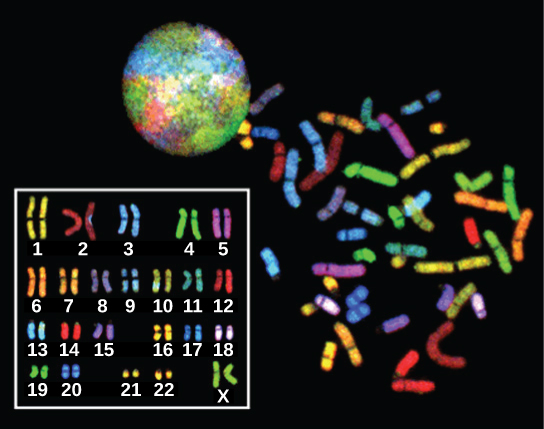9.2 An Overview of DNA and the Human Genome
Learning Objectives
By the end of this section, you will be able to:
- Describe the human genome
- Distinguish between chromosomes, genes, and traits
The continuity of life from one cell to another has its foundation in the reproduction of cells by way of the cell cycle. The cell cycle is an orderly sequence of events in the life of a cell from the division of a single parent cell to produce two new daughter cells, to the subsequent division of those daughter cells. Genetic information is found in the nucleus of cells. This information is stored in the chromosomes in the form of DNA. Chromosomes are difficult to see except for when they coil up tightly during cell division.
Genomic DNA
A cell’s complete complement of DNA is called its genome. In animals, the genome comprises several double-stranded, linear DNA molecules (Figure 9.8) bound with proteins to form complexes called chromosomes. Each species has a characteristic number of chromosomes in the nuclei of its cells. Human body cells have 46 chromosomes. A cell contains two matched sets of chromosomes, a configuration known as diploid. The letter n is used to represent a single set of chromosomes; therefore a diploid organism is designated 2n. Human cells that contain only one set of 23 chromosomes are called gametes, or sex cells. These eggs and sperm are designated n, or haploid.

The matched pairs of chromosomes in a diploid organism are called homologous chromosomes. Homologous chromosomes are the same length and have specific nucleotide segments called genes in exactly the same location, or locus. Humans have more than 20 000 genes, each with its own specific location on the chromosomal pairs. Genes, the functional units of chromosomes, determine specific characteristics by coding for specific proteins. Traits are the different forms of a characteristic. For example, the shape of earlobes is a characteristic with traits of free or attached.
So how do parents pass on these traits and genes to their offspring? During formation of gametes (sperm and egg cells), the cells divide and chromosomal pairs pull apart, half of each pair going into the nucleus of the sex cells. When sperm fertilizes the egg cell, the new cell gets half its genes from each parent. Each copy of the homologous pair of chromosomes originates from a different parent; therefore, the copies of each of the genes themselves may not be identical. The variation of individuals within a species is caused by the specific combination of the genes inherited from both parents. For example, there are three possible gene sequences on the human chromosome that codes for blood type: sequence A, sequence B, and sequence O. Because all diploid human cells have two copies of the chromosome that determines blood type, the blood type (the trait) is determined by which two versions of the marker gene are inherited. It is possible to have two copies of the same gene sequence, one on each homologous chromosome (for example, AA, BB, or OO), or two different sequences, such as AB.
Minor variations in traits such as those for blood type, eye color, and height contribute to the natural variation found within a species. The sex chromosomes, X and Y, are the single exception to the rule of homologous chromosomes; other than a small amount of homology that is necessary to reliably produce gametes, the genes found on the X and Y chromosomes are not the same.
Summary
Animals have multiple, linear chromosomes surrounded by a nuclear membrane. Human cells have 46 chromosomes consisting of two sets of 22 homologous chromosomes and a pair of nonhomologous sex chromosomes. This is the 2n, or diploid, state. Human gametes have 23 chromosomes or one complete set of chromosomes. This is the n, or haploid, state. Genes are segments of DNA that code for a specific protein or RNA molecule. An organism’s traits are determined in large part by the genes inherited from each parent, but also by the environment that they experience. Genes are expressed as characteristics of the organism and each characteristic may have different variants called traits that are caused by differences in the DNA sequence for a gene.
Exercises
- A diploid cell has ________ the number of chromosomes as a haploid cell.
- one-fourth
- one-half
- twice
- four times
- An organism’s traits are determined by the specific combination of inherited ________.
- cells
- genes
- proteins
- chromatids
- Compare and contrast a human somatic cell to a human gamete.
Answers
- C
- B
- Human somatic cells have 46 chromosomes, including 22 homologous pairs and one pair of nonhomologous sex chromosomes. This is the 2n, or diploid, condition. Human gametes have 23 chromosomes, one each of 23 unique chromosomes. This is the n, or haploid, condition
Glossary
diploid: describes a cell, nucleus, or organism containing two sets of chromosomes (2n)
gamete: a haploid reproductive cell or sex cell (sperm or egg)
gene: the physical and functional unit of heredity; a sequence of DNA that codes for a specific peptide or RNA molecule
genome: the entire genetic complement (DNA) of an organism
haploid: describes a cell, nucleus, or organism containing one set of chromosomes (n)
homologous chromosomes: chromosomes of the same length with genes in the same location; diploid organisms have pairs of homologous chromosomes, and the members of each pair come from different parents

